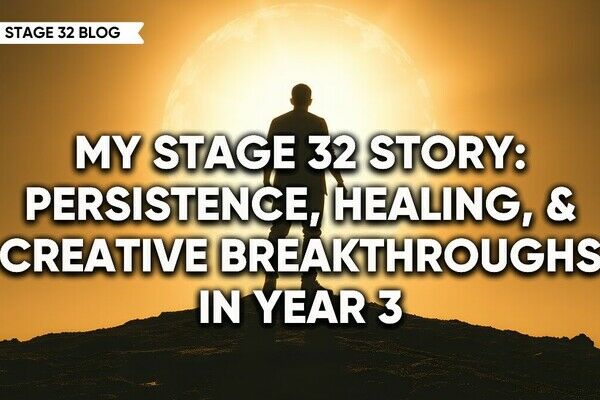How Therapy Can Make You a Better Actor Without Going Anywhere Near the Couch
In this article, I want to explore how therapy can enhance your acting. Not therapy to address your personal well-being during a challenging role—though that’s important—but rather how specific techniques from Gestalt Therapy and EMDR can be applied in acting classes or one-on-one coaching to help actors deliver more embodied, emotionally authentic, and vulnerable performances.
My Journey: From Aspiring Actor to Therapist—and Back Again
Acting has always been a fascination for me. At 21, I took a foundation course at a London theatre school and loved every moment. It felt like home. I even auditioned for their three-year program and got in! But financial concerns and doubts about acting as a viable career path led me to step away.
Fast-forward thirty years. After the heartbreak of my second IVF attempt failing, I found myself at a crossroads. I’d spent so much energy focused on expanding my family, and now I had to reimagine my future. What would my life look like without the second child I had hoped for?
It was during this reflective period that I returned to acting—not with career ambitions this time, but purely for the joy of it. I auditioned and was accepted into a part-time acting program.
But this time, it was different. I wasn’t just bringing enthusiasm to my training; I was also bringing:
- 13 years of experience as a Gestalt psychotherapist,
- 5 years of EMDR practice,
- 7 years of personal therapy, and
- Three decades of life experience.
I quickly realized how much more I had to offer as an actor than I did at 21. I credit much of this to my years in therapy. As a 21-year-old, I lacked the depth of self-awareness that came from therapy and life. To use a therapy word, I was very ‘defended’ against life. Due to childhood circumstances, I had learned to disconnect from certain difficult emotions. I also learned how to keep people and true contact at a distance. This had worked well for me as a child but was not useful at all when acting.
Gestalt Therapy, in particular, gave me tools to connect with my emotions, body, and inner life in ways that felt rich and expansive. Interestingly, one of Gestalt Therapy’s founders, Fritz Perls, was an actor before becoming a therapist, and he often used theatrical techniques for therapeutic purposes. Now, I found myself doing the reverse: applying therapy techniques to acting.
After a year and a half of training, my much-anticipated second child arrived. While acting has taken a backseat for now as I focus on solo parenting, I’ve discovered a new calling: supporting actors in their craft by integrating Gestalt and EMDR techniques into their training.

How Therapy Techniques Enhance Acting
Here are three key ways Gestalt Therapy and EMDR techniques can deepen and transform your craft:
1) Releasing Physical Tensions
One of the most common pieces of feedback I received from acting teachers was to connect more with my body. They wanted to see me *embody* my character—to give a performance where my physicality, movement, and presence matched the emotions I was expressing through words.
This is a challenge for many of us, especially today. We live in a time where mind and body feel increasingly separate. Most of us spend hours hunched over screens, and even when we engage in physical activities—like yoga or gym workouts—we often approach them transactionally, as tasks to complete.
But embodiment requires more than physical movement. It demands that we fully inhabit our bodies and emotions. This can be especially difficult for those who have experienced trauma or shame, which often leads to disconnection from the body.
Gestalt Therapy offers tools to bridge this gap. In a Gestalt session, for instance, I might ask someone to “speak as” their body part (e.g., “I am your aching head”). This helps bring awareness to how the body expresses emotions and unresolved tensions.
In acting, I use similar techniques to help actors connect with their physicality. For example, I might ask an actor to:
- Perform a short scene, then rate how embodied they felt.
- Repeat the scene while focusing on areas of tension or discomfort.
- Describe the tension aloud in the first person: “I’m clenching my stomach because I’m afraid to be seen.”
This process helps actors notice the unconscious ways their body holds emotions, allowing them to integrate these insights into their performances.
Tension in the body can be a significant barrier to authentic acting. It’s hard to convey vulnerability or presence when your shoulders are stiff, your jaw is clenched, or your movements feel robotic.
In a recent group coaching session, I guided actors through an exercise to address this:
- Initial Awareness: Actors performed a short scene and rated their embodiment on a scale of 1–10.
- Exploration: They repeated the scene, this time paying close attention to where they were holding tension.
- Exaggeration: Using a Gestalt technique, I asked them to exaggerate the tension (e.g., clenching their fists tighter or stiffening their posture further). This often brings hidden emotions or motivations to the surface.
- Reflection: Afterward, we discussed how these physical sensations connected to their characters’ emotional states.
- For example, one actor discovered that their stomach tension was tied to their fear of “exposing” themselves in front of an audience. By working through this, they found new ways to bring vulnerability to their character.

2) Connecting to Scene Partners
Acting is a relational art. As Uta Hagen famously said, “Ultimately, acting is about connecting with others and creating a shared experience.”
Gestalt Therapy places a strong emphasis on relationships, drawing on Martin Buber’s concept of *I-Thou* connections. In an *I-Thou* relationship, two individuals fully engage with each other in the present moment, without judgment or agenda. In their book The Healing Relationship in Gestalt Therapy, Hycner and Jacobs (1995) write: “When two people surrender to the “between”- called ‘existential trust’ - the possibility of I-Thou relation emerges”.
This kind of deep connection where the two actors are truly listening and being impacted by the other is what brings a scene to life.To cultivate this, I use exercises that help actors build relational presence. For example:
Actors pair up and take turns making three statements to each other:
- “I notice…” (e.g., “I notice you’re looking at me.”)
- “I imagine…” (e.g., “I imagine you’re feeling curious.”)
- “I feel…” (e.g., “I feel nervous.”)
The key is to focus on physical sensations and emotions, rather than thoughts or judgments.
This exercise often leads to profound shifts. Actors report feeling more present and connected, both to their scene partners and to their characters.

3) Soften the Critical Voice
“I can tell when you’re in your head,” one acting teacher told me. It’s feedback many actors hear, and it often stems from an overly active inner critic.
The critical voice can be ruthless, judging every line delivery and movement:
- “That was awful.”
- “The teacher doesn’t look impressed.”
- “I’m ruining this scene.”
In coaching sessions, I encourage actors to externalize this voice by imagining it as a character. They describe its appearance, age, and tone, then engage in a dialogue with it. The goal isn’t to silence the critic but to understand its intentions—often rooted in a desire to protect us from failure or shame.
By developing compassion for the critical voice, actors often find that it softens naturally, allowing them to perform with greater freedom and authenticity.
Final Thoughts
Therapy isn’t just for the couch. When applied thoughtfully, therapeutic techniques like those from Gestalt Therapy and EMDR can transform an actor’s craft, helping them:
- Connect more deeply with their bodies,
- Release physical and emotional tensions,
- Build authentic connections with scene partners, and
- Quiet the self-critical voice.
The result? Performances that feel alive, vulnerable, and profoundly human.
So, the next time you prepare for a role, consider how therapy techniques might enhance your process. You might just discover new layers of connection—to yourself, your character, and your audience.
Let's hear your thoughts in the comments below!
Got an idea for a post? Or have you collaborated with Stage 32 members to create a project? We'd love to hear about it. Email Ashley at blog@stage32.com and let's get your post published!
Please help support your fellow Stage 32ers by sharing this on social. Check out the social media buttons at the top to share on Instagram @stage32 Twitter @stage32 Facebook @stage32 and LinkedIn @stage-32
| Stage 32’s February 2025 Education Schedule! |
| Boost Your Creativity: A 7-Step Guide to Peace and Gratitude |
Search Stage 32 Blog
There are now 4043 blog posts for you to enjoy. Search them all by tags below.
Acting, Advice, Cinematography, Coffee & Content, Composing, Contests, Distribution, Featured, Filmmaking, Financing, Inspirational, Networking, Producing, Screenwriting, Success Stories, Tips, Trending,Relevant Tags
Recommended Articles

Insider Intel: The Studio War & The Rise of Indies

Insider Intel: 2026 Predictions

What Stage 32's Community Is Really About (Beyond Scripts, Sets, and Showreels)

Stage 32 Certification Featured In IndieWire!

4 Reasons To Have Audio Description On Your Film

Want Success in the Entertainment Industry? Start Writing Your Own Narrative

Stage 32 + DramaBox Join Forces to Launch World's First Vertical Drama Incubator

My Stage 32 Story: Persistence, Healing, & Creative Breakthroughs in Year 3

Coffee & Content: Reinvent the Story, Reinvent the Industry






